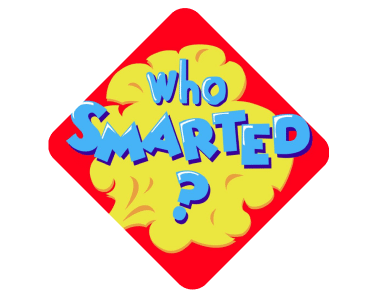What Is The Mysterious City Of Machu Picchu

Commercial
Hey parents, Trusty Narrator here, and I’m super excited to tell you about a brand new podcast from the creators of Who Smarted called Mysteries About True Histories. It’s full of adventure, riddles, jokes, we even snuck some secret M.A.T.H into each episode, including the title of the show. If your kid likes to laugh and learn, then they’re going to love Mysteries About True Histories. Out now wherever you listen to podcasts. And now it’s time for Who Smarted.
Narrator: Hey, smarty pants, show of hands, who wants to play a guessing game? Okay, I’m seeing a lot of hands. Nice. See if you can guess where I am. Oh, did you say somewhere where I’m out of breath? Possibly the gym, or hiking, or running to beat the lunch rush at my favorite pizzeria.
All great guesses, but no. Here, I’ll give you some potentially helpful hints. One, right now I’m at a place located high atop the Andes Mountain in South America. Two, the place I’m in is a country called Peru. Three, there’s lots of cool looking stone buildings and passageways. Four, there are many, many, many, many steps until you reach the top. And five, this place has one of the most fun names to say. And once you hear it, I guarantee you’ll be repeating it all day. In fact, it sounds like what you say when you sneeze, followed by the most famous Pokémon character.
Did you say Achoo Pikachu? Close. I’m at a place called Machu Picchu. Machu Picchu. Machu Picchu. Machu Picchu. I just love saying that, smarty pants.
Go ahead and say it with me. Machu Picchu. Nice job, smarties. Oh, and I’m here with my friend Camila.
Camila: Buenos dias. Good day, everyone.
Narrator: Camila is a cultural anthropologist. What’s that? Why, a cultural anthropologist is someone who studies human societies.
Camila: I also study how cultures develop.
Narrator: Terrific. And what are you studying at? Machu Picchu.
Camila: Today, I’m just taking some photographs for a travel magazine.
After all, Machu Picchu is a magical place full of history and mystery.
Narrator: How exciting. Think you’ll be able to double as a tour guide for me and the smarty pants?
Camila: It would be my pleasure, trustee. Si, you going to be okay? Huh?
Narrator: Who, me? I’m fine. I could use a short break.
Camila: Sure.
Let’s sit on these stones here and take a little agua fria break.
Narrator: Ah, that means water. Great idea, Camila.
I got to say, I might not be a world-class athlete, but I feel especially out of breath here.
Camila: There’s a reason for that. Not only is it warm out, but we are high up in the mountains.
Any guess how many feet we are above sea level?
Narrator: What do you think, smarty pants? Are we 1,000 feet above sea level? 3,000? 5,000? Or nearly 8,000 feet above sea level? If you said 8,000 feet, you’re right.
Camila: Whoa.
Narrator: That’s just over one and a half miles, or 2,500 meters for our metric friends. That’s pretty high up. So, why would that affect my breathing? Camila, care to explain while I catch my breath?
Narrator: At higher altitudes, the air is lighter. Lighter air means less oxygen, which means you have to take in more air to get the same amounts of oxygen as normal.
Narrator: It’s easy to forget about breathing when you’re surrounded by so much beautiful scenery. Look at those snow-capped mountains.
Camila: Yep. Few places are as breathtakingly beautiful as Machu Picchu. But there’s more to Machu Picchu than meets the eye. There’s also the region’s rich history.
Narrator: Good point, Camila. In fact, there’s lots to learn about Machu Picchu. Like, what exactly is it? Who created it? What purpose did it serve? And why did this architectural wonder go unoccupied for hundreds of years until it was rediscovered by an American explorer in search of a different lost city?
Camila: You have mucho Machu questions. I have mucho Picchu answers.
Narrator: Great. Then it’s time for another whiff of science and history on…
Theme Song: Who Smarted? Who Smarted? Who Smart? Is it you? Is it me? Is it science? Or history? Listen up, everyone. We make smarting lots of fun on Who Smarted?
Narrator: By the looks of things, Camila, I’m guessing this giant, elaborate stone compound wasn’t built recently.
Camila: That’s right, trustee. You have to go back some 600 years ago to the early 1400s. The people that inhabited this region were known as the Inca.
Narrator: Oh, I’ve heard of the Inca. Have you The Inca Empire was at one time one of the largest and most advanced civilizations in the world.
Camila: Yep. They started off as a small tribe, but grew into a giant empire consisting of ethnic Quechua people. They occupied much of the western coast of South America, from what is now Ecuador, all the way down to the bottom of Chile.
Narrator: Wow, that’s a large quarter of land, well over 2,000 miles long, nearly the width of the USA.
Camila: Yep. And the capital of the Inca Empire was close to where we are right now, in the city of Cusco, Peru.
Narrator: Got you.
Camila: It was the Quechuans who gave this place the name Machu Picchu, which translates to Old Peak in their native language.
Narrator: Ah, I was wondering what Machu Picchu meant.
Looking at some of these buildings, they appear as if they could have been used for royalty or other important figures of that time.
Camila: Indeed. There are several theories that have been passed around, and that’s one of the things that makes this place so intriguing.
Narrator: Ooh, intriguing is my middle name. Well, not really, but I love intriguing and pizza.
Camila: Some believe Machu Picchu served as a grand marketplace for villagers. Others say it may have been used as a prison. Or as a fortress. Or citadel. Some theorize, due to its proximity to the skies and the beliefs in many gods, that it was a sacred religious compound.
Narrator: Those are very different, yet intriguing, theories.
Camila: The consensus among many historians is that it was built as a royal estate for the first Inca Emperor, named Pachacuti Yupanqui.
Narrator: Hey, his name is almost as much fun to say as Machu Picchu. Oh, sorry. You were saying?
Camila: It was believed the emperor would hold great feasts and religious ceremonies here, in addition to overseeing his expanding empire. And you’re right. It is fun to say Pachacuti Yupanqui.
Narrator: I will say, Machu Picchu seems way too big for just one family to live here.
Camila: For sure. With over 150 structures, it’s estimated it took about 1,000 people to service this compound. Whoa.
Narrator: Based on the various types of buildings and terraces, I’m guessing this place was pretty self-sufficient. They didn’t have to go running up and down the mountain every time they needed something.
Camila: It sure was. Stone channels and drainage systems were constructed to capture rainwater, as well as the snow runoff that occurs at this altitude. Rows of terraced gardens were abundant, so crops could be grown and harvested, all supplied by the indigenous irrigation system they created.
Narrator: Go Machu. Go Picchu. Oh, right. Say, Camila, what’s that structure over there?
Camila: That, my amigo, is believed to be an observatory.
Narrator: As in stars, planets, and galaxies?
Camila: Exactly. Astronomy played an important role in the Inca Empire. It dictated their agriculture, religion, and many other aspects of their daily life.
In fact, Emperor Pachacuti claimed to be a descendant of the sun.
Emperor Pachacuti: Behold, I, Emperor Pachacuti, am a descendant of the sun! Or I think I am. I’m like, I’m pretty sure.
Camila: Sections of the observatory served different functions, such as predicting the solstice. There are also rooms where they could discuss various constellations and their meaning or purpose
Narrator: . The architecture is rather unique, unlike anything I’ve ever seen before.
Camila: Well observed, trustee. The Inca civilization is known for being way ahead of its time, and the methods used to create this compound reflect that. One example that stands out is the stonework.
It’s not like typical structures made of evenly cut, identical bricks with cement or mortar holding them together.
Narrator: Right. The stones of Machu Picchu are all different sizes, yet they fit together perfectly, almost like a puzzle.
Camila: Very true. In fact, the stones making up Machu Picchu were cut so precisely and fit together so snugly, they didn’t require mortar at all. It’s a technique known as ashlar.
Go ahead, try and wedge a piece of paper between two rocks.
Narrator: I can’t! That’s incredible! You got to wonder what tools they used to create this. True or false, Smarty Pants? Instead of tools, they used other rocks to construct Machu Picchu.
Camila: The answer, surprisingly, is true. Investigations of nearby quarry sites show no signs of iron, which tells us they used harder stones to pound pieces of granite, usually along the fracture lines, so they would split open and could then be smoothed over. The Incas were considered to be some of the best stone masons ever, and were masters of this process.
The technique they used has proven to be quite successful in terms of maintaining Machu Picchu’s structural integrity over the centuries since it was built.
Narrator: Great point. In fact, it’s even more impressive considering this region is highly susceptible to certain types of natural disasters.
Smarty Pants, see if you can guess which natural disaster is most likely to occur in this region. Is it A. Hurricanes B. Earthquakes Or C. Tidal waves If you said B. Earthquakes, you’re right! But how is this structure, made of rocks, able to survive lots of earthquakes?
Camila: The answer is…
Narrator: Right after this quick break.
Commercial
Hi, Trusty here with a special message for all the parents and guardians listening.
I know how important it is for your child to excel in every way possible, especially when it comes to education. Well, thanks to my friends at IXL, you don’t have to go it alone. IXL is a personalized learning platform that’s transforming the way children master everything from math to social studies.
IXL’s interactive courses and immediate feedback ensure learning is super engaging and accessible for every student, pre-K through 12th grade. Imagine that. A tool that grows with your child, offering personalized recommendations based on their progress.
And we know it works because we’ve used it ourselves. Adam ‘Tex’ Davis, co-creator of Who’s Used IXL to help his daughter stay on top of her schoolwork and excel in her classes. Backed by research, students who use the IXL program are more likely to get higher test scores because IXL functions like a tutor.
And whether your child needs help with homework, classwork, test prep, or is looking for a challenge, IXL has you covered. And all of that at an affordable rate. A one-month subscription to IXL costs less than what most tutors charge for an hour.
And one subscription is good for every child in your household. Join the millions of parents who trust IXL and make an impact on your child’s learning today. Oh, and Who’s Smarted listeners get an exclusive 20% off IXL membership when you sign up now at IXL.com/smarted.
Visit IXL.com/smarted to get the most effective learning program out there at the best price. IXL learning. Inspire. Excel. Learn more at IXL.com.
Commercial
Hey there smarty moms, dads, adults, and anyone who loves great food but doesn’t always have the time or energy to grocery shop, prep, and cook a big meal. Well, take it from me, the trusty narrator.
I found the perfect solution to having delicious, home-cooked meals without all the time and hassle. It’s called Factor Meals. With Factor Meals, you can forget about all the shopping, chopping, or even washing dishes.
That’s because Factor’s fresh, never-frozen meals arrive at your door ready to heat and eat in just 2 minutes. That’s right. With Factor, you and your family are always just 2 minutes away from chowing down on chef-crafted, dietitian-approved, delicious gourmet meals.
From calorie smart to protein plus to vegetarian to keto options, Factor has six menus guaranteed to meet your wellness goals. And with over 35 meal choices and 60 add-ons weekly, your taste buds will never get bored. I personally started ordering Factor Meals last month for those busy days when I want a tasty lunch or dinner that fills me up and crushes my nutrition goals, but I only have 5 minutes to cook it.
And Factor 100% delivers on time, every time. So, head on over to factormeals.com/SMARTED50 and use code SMARTED50 to get 50% off your first box plus 20% off your next month. That’s code SMARTED50 at factormeals.com/SMARTED50 to get 50% off your first box plus 20% off your next month while your subscription is active.
Narrator: Now back to Who Smarted?
The stone structures of Machu Picchu have stood for over 600 years, surviving many an earthquake. But how?
Camila: Remember before when we said they didn’t use mortar or cement between the stones?
Narrator: Yeah?
Camila: Well, because of that, the stones are able to adjust and resettle as the ground trembles. There’s no cracking along seams or collapsing of walls.
This is especially useful since Machu Picchu was constructed along two fault lines.
Narrator: Amazing! I also noticed nearly all the doors and windows are not rectangles or squares like windows back home. Instead, they’re a different shape.
Camila: Yep. The Inca architects discovered over time that a trapezoid doorway and windows helped increase stability during seismic events like earthquakes. Narrator: Those Incas sure were ancient smarty pants.
But wait, now that I’m looking at all these stones, how did they transport them all up to the top of a high mountain range? I can barely walk a flight of stairs here and that’s without carrying giant rocks. Cranes and trucks didn’t exist back then. So, how?
Camila: Much of the stone was either carried by llama or hauled up using ropes, logs, and wooden ramps.
I can only imagine how much strength that took.
Narrator: And llamas! Now, I got to ask, if everything around here was built so securely and self-sufficiently, why was Machu Picchu only occupied for about 100 years starting in the early 1400s?
Camila: Good question, trustee. Along with why it was built, it is also a mystery why Machu Picchu was abandoned 100 years after it was constructed.
Some say it was because soldiers were needed elsewhere to fight the Spanish conquistadors. Others attributed to outbreaks of measles and smallpox.
Narrator: Well, that’ll do it.
Camila: It wasn’t until 1911 that an American archaeologist and explorer named Hiram Bingham came across Machu Picchu while on an expedition searching for the lost city of Vilcabamba, which was thought to be the last Inca stronghold to fall to the Spanish empire.
Narrator: Interesting!
Camila: Word has it Bingham and his team were searching for the Urabamba Valley below when a local farmer told them of an outcrop of stone buildings located way up at the top of the mountain. Bingham would go on to write about this discovery, which eventually drew tourists from around the world to Machu Picchu or Old Peak.
Narrator: Yep, and in 2007, Machu Picchu joined other iconic structures like the Great Wall of China, the Taj Mahal, and the Roman Coliseum as one of the new Seven Wonders of the World. My biggest wonder is how am I going to make it up all these stairs?
Outro
A super shout out to super fan Aria in Christchurch, New Zealand. Not only does Aria love Who Smarted so much, she also drew an amazing picture for me and the whole Who Smarted crew to enjoy.
Thanks so much, Aria, and we’re so glad to have you smarting with us and part of our smarty family. This episode, Machu Picchu, was written by Dave Discovery Davis and voiced by Machu Melissa Del Toro Schaffner, Max Lost City Kamaski, and Jerry Kolber. Technical direction and sound design by Josh Holyland Han.
Who Smarted is recorded and mixed at the Relic Room Studios. Our associate producer is Max Kamaski. The theme song is by Brian Picchu Suarez with lyrics written and performed by Adam Inca Davis.
Who Smarted was created and produced by Adam ‘Tex’ Davis and Jerry Kolber. This has been an Atomic Entertainment production.
Theme Song: Who Smarted?
Commercial:
Hey there, it’s trusty. And you know I love sitting at home listening to good podcasts. As much as I love going on adventures. And do I have a great one to recommend to all you Smarty pants and smarty parents from the award-winning GoKidsGo team. It’s called Snoop and Sniffy. What happens when Snoop, an experienced dog detective from London gets sent to small town Pflugerville to train clueless puppy sniffy as an undercover agent. Mystery, advent and chaos.
Seriously, the town of Pflugerville isn’t Dogsville like Snoop expected, and he quickly realizes that he can’t handle all the action without sniffy by his side, even when they’re able to turn a blind eye to the alien. Superheroes and villains battling it out for control of Pflugerville, Snoop and Sniffy have their paws full, solving wild and wacky mystery cases on Bark Street. Do you love to laugh? Do you love animals? Do you have the brightest mind since Sherlock Holmes? Then tag along. There are already eight seasons of hilarious canine crimes to solve.
Search for Snoop and Sniffy on Apple, Spotify, or wherever you get your podcasts.
[End of Ttamscript 20:46]


